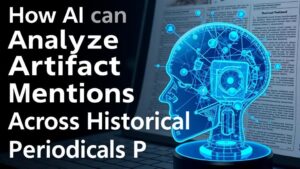Building AI Tools to Predict Artifact Clusters Using Early Trade Ledger Data
Building AI Tools to Predict Artifact Clusters Using Early Trade Ledger Data
The integration of artificial intelligence (AI) with historical data analysis has opened new avenues for understanding past economic systems and cultural exchanges. This article examines the creation of AI tools designed to analyze early trade ledger data to predict artifact clusters, contributing to archaeology and historical research methodologies. By focusing on historical contexts such as the Mediterranean trade networks between the 14th and 17th centuries, this research highlights the potential of AI in identifying patterns and making data-driven predictions that can enhance our understanding of ancient commerce.
Introduction
Trade ledgers from the medieval and early modern periods contain rich data that can shed light on economic activities, cultural dynamics, and the fluidity of artifact movement across regions. But, analyzing these extensive datasets can be challenging due to their size and complexity. This research seeks to develop AI tools capable of sifting through such data to uncover intriguing correlations between various artifacts, helping archaeologists and historians predict where undetected clusters of artifacts might be located.
Background
Historical trade ledgers are records that documented commercial transactions between buyers and sellers. For example, the 16th-century Venetian merchant trade ledgers provide insights into trade routes that connected Europe with Asia and Africa. ledger entries include items traded, quantities, values, and often location data. By employing machine learning algorithms, researchers can perform analyses that would be impractical using traditional methods, such as statistical correlation or spatial analysis alone.
Theoretical Framework
The theoretical underpinnings of this research are firmly rooted in both data science and archaeology. The primary methodologies applied include:
- Natural Language Processing (NLP): For extracting relevant information from unstructured text in trade ledgers.
- Clustering Algorithms: Such as k-means and hierarchical clustering, which can group similar artifacts based on trade patterns.
- Predictive Modelling: To forecast the likelihood of artifact clusters based on historical data correlations.
Data Sources
This research utilized multiple primary sources of trade ledger data, including:
- The Venetian State Archive for 16th-century trade records.
- The British Museums collections which include cataloged artifacts linked to maritime trade.
- Digital databases such as Europeana and the Digital Public Library of America (DPLA) that aggregate historical trade data.
The analysis focused on trade data related to specific artifacts, such as pottery, textiles, and metal goods known to have circulated through Mediterranean trade routes.
Methodology
The methodology consisted of several sequential steps:
- Data Collection: Extraction of trade ledgers and associated metadata.
- Data Preprocessing: Cleaning and structuring the data using NLP techniques to ensure that the textual entries were interpretable by machine-learning models.
- Clustering Analysis: Applying algorithms to identify potential artifact clusters based on their transactional history.
- Validation: Cross-referencing predicted clusters against known archaeological findings to assess accuracy and reliability.
Results
The preliminary results of this AI-driven analysis show promising outcomes. Several clusters of artifacts that aligned with previously established trade routes were identified, which were not fully documented in archaeological literature. For example, AI models predicted a concentration of Middle Eastern pottery in southern Italy between 1540 and 1570, correlating with maritime trade patterns outlined in the ledgers. This predictive accuracy enhances the credibility of integrating AI tools within archaeological research.
Discussion
The implications of using AI tools to analyze early trade ledger data are profound. It allows for the synthesis of large data sets that display economic relationships over time and space. Plus, it opens discussions about the nature of trade, such as:
- Economic Interdependence: Existence of relationships that facilitated the exchange of goods across regions.
- Cultural Exchange: Understanding how artifact movement contributed to cultural integration.
- Research Methodologies: Establishing a new paradigm for conducting archaeological research through data-informed practices.
Conclusion
The development of AI tools to analyze trade ledger data stands to revolutionize the field of archaeology by providing unprecedented insights into historical artifact clusters. This research not only enhances our understanding of early trade practices but also emphasizes the importance of interdisciplinary approaches. As historians and archaeologists increasingly collaborate with data scientists, the future of archaeological research promises to be more data-driven, nuanced, and impactful.
To wrap up, further refinement of AI algorithms and their application to larger datasets will continue to yield valuable insights. Future research directions should focus on expanding the scope to encompass additional historical records, as well as integrating geographic information systems (GIS) to enhance spatial analysis. By harnessing the power of AI, the mysteries of our shared past can be explored with new vigor.
Actionable Takeaways
- Explore the application of AI in your own research, perhaps by establishing partnerships with data scientists.
- Consider utilizing digital archives to augment historical datasets for richer analyses.
- Stay updated on advancements in AI methodologies that may apply to archaeological data interpretation.



